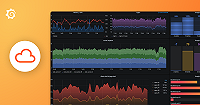Important: This documentation is about an older version. It's relevant only to the release noted, many of the features and functions have been updated or replaced. Please view the current version.
Configure Pyroscope disk storage
Pyroscope’s ingester component processes the received profiling data.
First it keeps the data organized in memory, in the so-called “head block”. Once
the size of the head block exceeds a threshold or the head block is older than
-pyroscopedb.max-block-duration (by default 3 hours), the ingester will write
the block to the local persistent disk (see block format for more detail about
the block’s layout). Each of those blocks are identified by an ULID and stored
within Grafana Pyroscope’s data path -pyroscopedb.data-path= (by default
./data). This directory is organized by the following:
./<tenant-id>: Each tenant has its own subdirectory with the following subdirectories:head/<block-id>: Contains the current data still being written.local/<block-id>: Contains the finished blocks, which are kept locally
Object storage
When object storage is configured, finished blocks are uploaded to the object store bucket.
High disk utilization
To avoid losing the most recent data, Pyroscope will remove the oldest blocks
when it detects that the volume on which the data path is located is close to
running out of disk. This high utilization mode will be active every
-pyroscopedb.retention-policy-enforcement-interval when:
- less than
-pyroscopedb.retention-policy-min-disk-available-percentage=0.05of the total size of the volume is available and - the available disk space smaller then
-pyroscopedb.retention-policy-min-free-disk-gb=10.
The deletion will be logged like this:
level=warn caller=pyroscopedb.go:231 ts=2022-10-05T13:19:09.770693308Z msg="disk utilization is high, deleted oldest block" path=data/anonymous/local/01GDZYHKKKY2ANY6PCJJZGT1N8

